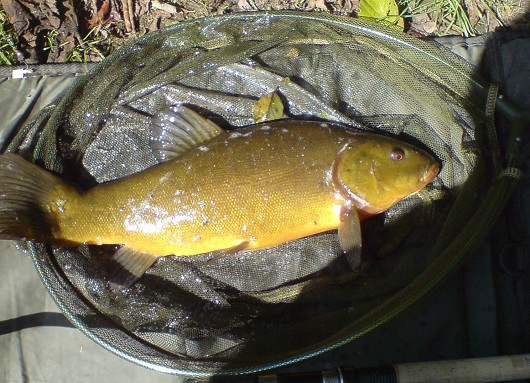Tench
-
Scientific NameTinca tinca
-
NativeNon-Native
-
Identification
 Tench, caught in Storrington, West Sussex, England on 19 August 2009. Photo by Peter Collington.
Tench, caught in Storrington, West Sussex, England on 19 August 2009. Photo by Peter Collington.- Deep and thick body
- Tiny, deeply embedded scales
- Small terminal mouth with a single barbel at the end of each maxilla
- Color varies from dark green to black on the back, bronze on the sides and belly, and dark on the fins
- Square caudal fin but well rounded anal and dorsal fins
- 8-9 dorsal and anal fin rays
- Males have a thick ray on the leading edge of their pectoral fins
-
Life History
Tench are most commonly found in warm, quiet waters with muddy bottoms including farm ponds, oxbow lakes, sloughs, deep, slow moving rivers, and, in their native European territories, castle moats. They can survive in water with less than 1 ppm of dissolved oxygen and in salinities as high as 12 ppt. It is possible that they can survive in temperatures as low as freezing and as high as 30-35°C but 12-30°C seems to be the optimum temperature for growth. It is also possible that the introduced California populations are not as resistant to cold as European populations. In general tench are a solitary fish, very passive towards neighboring species, and reluctant to migrate. They will forage at night and seek cool cover during the day in deep holes and shady areas like cattail beds. Their diet is very dependent on their size and what resources are available. Young fish tend to eat mainly small crustaceans until they reach about 6 cm, at which point they shift towards insect larvae like mayflies and damsel flies. When they grow larger than 12 cm this diet is no longer sufficient and they focus their feeding on whatever large invertebrates (snails, worms, etc.) are most available. In cases of overcrowding and invertebrate depletion, aquatic plants or algae can be consumed but it is unlikely that a diet of just these materials would keep a tench population alive.
Tench reach maturity between ages 3 and 4 with females generally maturing a year later than males. Spawning starts in the summer when temperatures reach 18°C and centers around aquatic vegetation to which the eggs can stick. Females generally lay 500,000 eggs per kg of body weight. These eggs hatch 6-8 days later into 2-3 mm fry. They will grow 3 cm a year for the next 4 years at which point their growth begins to slow. By the time they reach 30 cm they may be 9 years or older. Weights have been recorded as high as 4 kg in Europe but only between 2 and 3 kg in California. It should be noted that due to the lack of local studies on this species, beyond the weight measurement, all of this information is based on studies from Europe and Tasmania.
-
Links to Other ResearchN / A
-
WatershedN / A
Please note, watersheds are at the USGS 8-digit Hydrologic Unit Code (HUC) scale, so they often include a lot of sub-watersheds. If a species occurs in any sub-watershed within the HUC, the species appears within the HUC. Link to an EPA page that shows HUCs.
